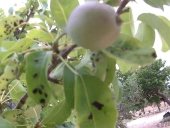Hi everyone. I've been enjoying this thread, so decided to contribute.
Here in South Italy the Opuntia ficus-India has long been naturalized. I recently heard a story from an old man here, in goes something like this:
Once upon a time in Sicily there man who didn't get along his neighbour and they fought and disputed with each other all the time. So one day in Spring when his neighbour wasn't around, the man decided to get revenge and ruin his neighbour's prickly pear crop. He sneaked into his neighbour's property and removed all the fruit from the blooming cactii. Come summertime, the neighbour's prickly pear didn't produce any fruit and he was most displeased. He got the last laugh however because come at the end of autumn he got a late crop of fruit and these were sweeter, larger and had less spines and seeds.
The normal fruiting will be from July-September. By removing the young flowering fruit in Spring however, you'll get a late harvest from October-December, extending the growing season by 3 months!
This process is called scozzolatura, see
for a short video.
Anyone else fimiliar with the process? I've never tried it myself. Now is the time to do it however, as the plants have just started to bloom. Not sure whether I have to remove all the fruit from each cactus plant or whether I can just remove half so I can get an early and late crop from the same plant. Any ideas?











